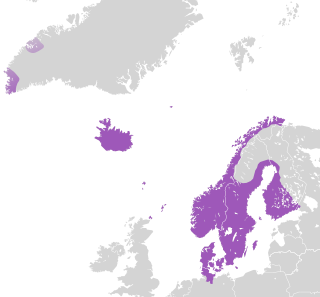The Kalmar Union was a royal personal union consisting of the kingdoms of Denmark, Norway and Sweden, and various other provinces and areas. At that time, Norway included Iceland, Greenland, the Faroe Islands, Jan Mayen, Shetland, and Orkney. Parts of Finland belonged to Sweden. The union was started in 1397 when Eric of Pomerania was crowned in the town of Kalmar in Sweden. The union ended on 6 June 1523 when Sweden left the union by Gustav I.[1]
Quick facts Status, Capital ...
-
Kalmarunionen (in Danish, Norwegian, and Swedish)Kalmarin unioni (in Finnish)Kalmarsambandið (in Icelandic)Kalmar unioni (in Greenlandic)Kalmarsamveldið (in Faroese)Unio Calmariensis (in Latin)
|
|---|
|
Arms of Eric of Pomerania
|
 |
| Status | Personal union |
|---|
| Capital | Copenhagen (from 1443) |
|---|
| Common languages | Official use: Middle Danish, Old Swedish, Renaissance Latin
Also spoken: Middle Low German, Finnish, Karelian, Middle Norwegian, Middle Icelandic, Norn, Sami languages, Greenlandic Greenlandic Norse |
|---|
| Religion | Roman Catholicism |
|---|
| Government | Personal union |
|---|
| Regent | |
|---|
|
• 1387–1412a | Eric of Pomerania (first) |
|---|
• 1524–33 | Christian II (last) |
|---|
|
|
| Legislature | Riksråd and Herredag (one in each kingdom) |
|---|
| Historical era | Late Middle Ages |
|---|
|
• Established | 17 June 1397 |
|---|
• Engelbrekt rebellion | 1434–36 |
|---|
• Stockholm Bloodbath | November 1520 |
|---|
| 6 June 1523 |
|---|
• the Danish Rigsråd annexes Norway | 1536 |
|---|
• Disestablished | 1523 |
|---|
• Treaty of Kiel | 14 January 1814 |
|---|
|
|
| Currency | Mark, Örtug, Öre, Swedish penning |
|---|
| Preceded by | Succeeded by |
|
Denmark |
|
Hereditary Kingdom of Norway |
|
History of Sweden (800–1521) |
|
|
|
| Today part of | |
|---|
- Margaret I ruled Denmark between 1387–1412 and Norway between 1388–1389. She also ruled Sweden between 1389–1412
- Parts of these countries today. Back then they belonged to the three main countries of the Kalmar Union; Denmark, Norway and Sweden.
|
Close



